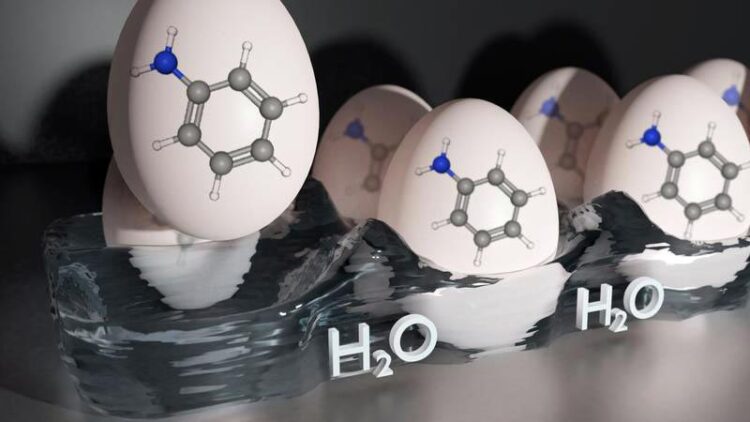Molecules in an egg carton

A team at the MPI for Polymer Research has investigated how molecules can arrange themselves under the control of a water surface.
© MPI-P
How water surfaces can be used to produce functional materials.
The production of high-quality monolayers – i.e. only one molecule high – is highly relevant for optoelectronic components such as organic light-emitting diodes used today in modern cell phones: Both lifetime and energy efficiency can be increased. Scientists at the Max Planck Institute for Polymer Research, through a collaboration with TU Dresden, have now used lasers to investigate how water surfaces can be used as a template for the regular arrangement of molecules and what physicochemical mechanisms underlie this.
Organic light-emitting diodes consist of many thin layers, some of which are only one molecule thick. “On-water chemistry” – the use of water surfaces to influence chemical reactions – discovered back in the 1980s, is a promising candidate for producing such layers. Like an egg carton, this type of chemistry offers the possibility of selectively forcing molecules into a crystalline – i.e., regularly arranged – structure: They can only sit where the surfactants on the water surface allow them to.
Until now, it was unclear what physical and chemical processes are operative to achieve this arrangement. For example, what role does the charge of the surfactant play? To what extent do bond distances on the water surface have to match those of the applied molecule?
Yuki Nagata, group leader in Mischa Bonn’s department at the MPI for Polymer Research, and his team have addressed these questions. For this purpose, they used the molecule “polyaniline” as an experimental object and investigated the process of arrangement on the water surface in more detail using laser spectroscopy.
Sum-frequency generation spectroscopy (SFG) is ideally suited for this purpose, as it only provides signals from the interface and not from the underlying water. With its help, the team was able to map the polymerization process over a period of several hours and also detect any intermediates that were formed.
“We were able to show that the charge on the surface matters for the quality of the synthesized samples,” Nagata said. “We hope that our research will provide the way to produce tailored polymeric coatings by tailoring the water surfaces accordingly.”
The team’s findings have now been published in the October issue of the journal Chem.
Wissenschaftliche Ansprechpartner:
Dr. Yuki Nagata
+49 6131 379-380
nagata@mpip-mainz.mpg.de
Originalpublikation:
Real-time study of on-water chemistry: Surfactant monolayer-assisted growth of a crystalline quasi-2D polymer
https://doi.org/10.1016/j.chempr.2021.07.016
Media Contact
All latest news from the category: Life Sciences and Chemistry
Articles and reports from the Life Sciences and chemistry area deal with applied and basic research into modern biology, chemistry and human medicine.
Valuable information can be found on a range of life sciences fields including bacteriology, biochemistry, bionics, bioinformatics, biophysics, biotechnology, genetics, geobotany, human biology, marine biology, microbiology, molecular biology, cellular biology, zoology, bioinorganic chemistry, microchemistry and environmental chemistry.
Newest articles

Innovative 3D printed scaffolds offer new hope for bone healing
Researchers at the Institute for Bioengineering of Catalonia have developed novel 3D printed PLA-CaP scaffolds that promote blood vessel formation, ensuring better healing and regeneration of bone tissue. Bone is…

The surprising role of gut infection in Alzheimer’s disease
ASU- and Banner Alzheimer’s Institute-led study implicates link between a common virus and the disease, which travels from the gut to the brain and may be a target for antiviral…

Molecular gardening: New enzymes discovered for protein modification pruning
How deubiquitinases USP53 and USP54 cleave long polyubiquitin chains and how the former is linked to liver disease in children. Deubiquitinases (DUBs) are enzymes used by cells to trim protein…



